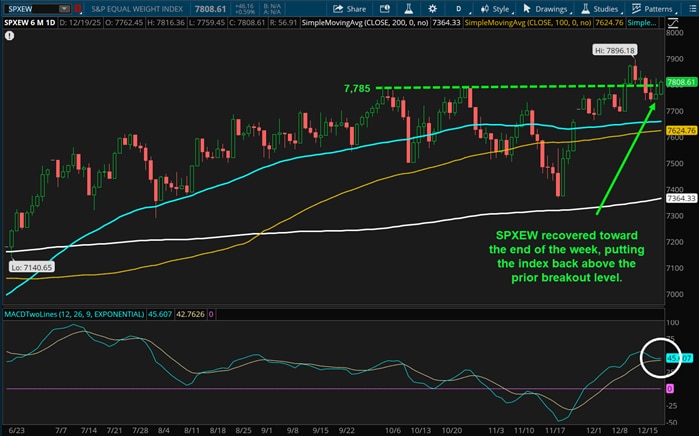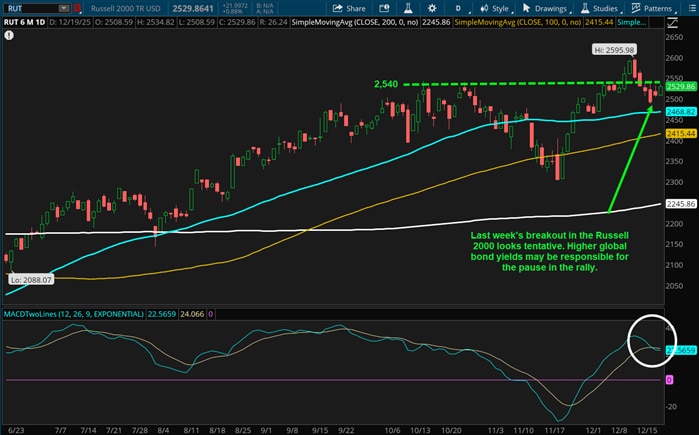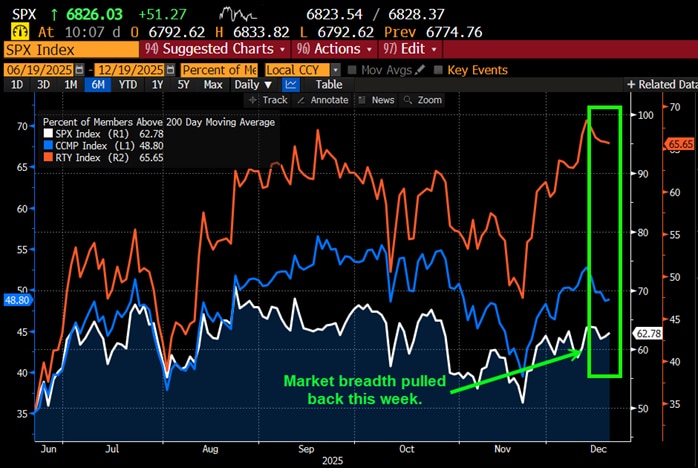Weekly Trader's Outlook
Will Santa Claus Visit Wall Street This Year?

Note: Due to Christmas and the shortened trading week, we will not publish a Weekly Trader's Outlook on Friday, December 26th.
The Week That Was
If you read last week's blog, you might recall that my forecast for this week was "Moderately Bullish," citing last week's technical breakouts in the SPXEW, RUT, and DJI to fresh all-time highs. I thought the bullish momentum in the rotation trade would flow through this week, but all the major indices are flat to slightly down this week, so my forecast was off. Selling in tech stocks during the first half of this week, driven by lingering AI concerns, spilled over into overall market sentiment, though stocks have managed to recover over the last 48 hours. The recovery in the back half of the week was driven by a strong "beat and raise" quarter from Micron Technology and cooler-than-expected consumer price index (CPI) data, specifically on the year-over-year gains. Markets also received Nonfarm Payrolls and retail sales data, though the reports were met with a bit of skepticism given the government shutdown and accuracy of the data (more on this in the "Economic Data, Rates & the Fed" section below). Also garnering some attention from investors this week is a contrarian sell signal from Bank of America (BofA) earlier this morning. The banking giant said that its "Bull & Bear Indicator" rose from 7.9 to 8.5 in the past couple of days, indicating a high level of bullishness among fund managers, which historically has signaled poor three-month forward-looking returns. BofA analyst Michael Hartnett said that this "sell signal" has been triggered 16 times since 2002, and on average, the MSCI All-Country World Index has declined 2.4% over the next three months, with a maximum average drawdown of 8.5%. There's no guarantee that history will repeat itself, and it doesn't necessarily negate the potential for a Santa Claus rally on Wall Street, but it does suggest that bullish sentiment could be currently stretched.
Outlook for Next Week
At the time of this writing (3:10 p.m. ET), stocks are higher across the board, but off the highs of the session at the time of this writing (DJI + 225, SPX + 60, $COMP + 269). Treasury yields are also modestly higher today but are net lower on the week. Next week will be holiday-shortened and there doesn't appear to be many market-moving catalysts next week, and trading volume is expected to be light, which could suggest the potential for higher volatility. It's a difficult environment to forecast which direction markets are likely to move, not only because there were a lot of mixed economic signals this week, but there's also a mixed technical picture. The late week recovery in the SPXEW is encouraging, but the price action in the Russell 2000 looks murky at this current juncture. Yes, the intermediate and longer-term technical trend in all the majors is bullish, but very near-term there isn't a decisive trend in my view (more on this in the "Technical Take" section below). I'm also not sure if there will below). I'm also not sure if there will be a continuation of the rotation trade into non-tech areas of the market, or whether year-end performance chasing/window dressing will breathe life back into the technology sector. However, the seasonality remains bullish and if a Santa Claus rally is going to manifest, it would technically start next Wednesday. Therefore, I'm providing an overall "Slightly Bullish" forecast for next week, but the price action could be choppy. What could challenge my forecast? Rising U.S. Treasury/global bond yields seems to be the most likely culprit in my view.
Other Potential Market-Moving Catalysts
Economic:
- Monday (Dec. 22): no reports
- Tuesday (Dec. 23): Capacity Utilization, Durable Orders, Q3 GDP – Advanced Reading, Industrial Production, New Home Sales
- Wednesday (Dec. 24): Continuing Claims, EIA Crude Oil Inventories, EIA Natural Gas Inventories, Initial Claims, MBA Mortgage Applications Index
- Thursday (Dec. 25): no reports
- Friday (Dec. 26): no reports
Earnings:
- Monday (Dec. 22): Bright Minds Biosciences Inc. (DRUG), Ennis Inc. (EBF)
- Tuesday (Dec. 23): Bridgeline Digital Inc (BLIN), Limoneira Co. (LMNR)
- Wednesday (Dec. 24): no reports
- Thursday (Dec. 25): no reports
- Friday (Dec. 26): Citius Pharmaceuticals Inc. (CTXR), Outlook Therapeutics Inc. (OTLK)
Economic Data, Rates & the Fed
There was a heavy dose of economic data for investors to digest this week, highlighted by Nonfarm Payrolls data for October/November, retail sales data and a monthly CPI report. Based on the reaction in Treasury yields, the jobs data was characterized as soft, but the surprise jump in the Unemployment Rate (4.6% vs. 4.4% est.) was impacted by an increase in the labor force participation rate, so the labor market softness may not be as dramatic as initially thought. There was also a knee-jerk reaction to the cool inflation data, but Thursday's CPI report did not have all the usual data points of a typical release because the Bureau of Labor Statistics (BLS) was unable to retroactively collect them, so the data should be taken with a grain of salt. Here's the breakdown from this week's reports:
- Nonfarm Payrolls (October and November): Dropped 105,000 in October but rose by 64,000 in November. The November gains were better than the +40-50K economists had expected while the October losses were primarily driven by federal government cutbacks.
- Unemployment Rate: 4.6% vs. 4.4% est.
- Average Hourly Earnings: Rose 0.1% in November, slightly below the +0.2% estimates, which equates to a +3.5% annual change.
- Retail Sales (October): The headline figure came in slightly below estimates (0.0% vs. +0.1% expected), but retail sales ex-autos were slightly better (+0.4% vs. +0.3% expected). The Control Group, which excludes volatile categories (auto dealers, gas stations, building materials, etc.) and feeds directly into GDP, was well above estimates (+0.8% vs. +0.4% expected).
- Consumer Price Index (CPI): Both headline and core figures were in line with estimates (+0.2% vs. +0.2% expected), but the annual figures both surprised to the downside–headline +2.7% was below the +3.1% estimate and core +2.6% was below the +3.0% economist had expected.
- Empire State Manufacturing: -3.9 vs. 12.5 est.
- Initial Jobless Claims: Initial applications for U.S. jobless benefits dropped 13K from last week to 224K, which was slightly below the 225K economists had expected. Continuing Claims rose to 1.897M from 1.83M week-over-week but were below the 1.93M estimate.
- EIA Crude Oil Inventories: -1.27M barrels
- EIA Natural Gas Inventories: -167 bcf
- The Atlanta Fed's GDPNow "nowcast" for Q3 GDP was revised slightly lower to 3.5% on Tuesday from +3.6% on December 11th, which was primarily driven by modest decreases in consumer spending and inventory investment.
U.S. Treasury yields declined across the board this week, despite a lift in yields overseas. The Bank of Japan (BOJ) delivered a 25-basis-point rate hike and Japan Government Bonds (JGB) subsequently hit multi-decade highs. Compared to last Friday, two-year Treasury yields are down ~5 basis points (3.485% vs. 3.531%), 10-year yields are also lower by ~5 basis points (4.147% vs. 4.194%), while 30-year yields eased ~3 basis points (4.825% vs. 4.858%).
Expectations for rate cuts from the Federal Reserve are little changed versus last Friday, despite this week's cooler-than-expected CPI report and soft jobs data. Per Bloomberg, the probability of the next 25-basis-point cut from the Fed in 2026 is either April (88% vs. 81% last week) or June (theoretical 100%). The probabilities are still pointing to a total of two 25-basis-point cuts in 2026, even though the latest revisions to the Fed's dot plot only suggest one in 2026 and one in 2027.
Technical Take
S&P 500 Equal Weight Index (SPXEW + 45 to 7,808)
Last week I noted the breakout in the SPXEW to new all-time highs and stated, "While the breakout to fresh all-time highs is an obvious bullish technical event, the bulls would like to see the index hold ground above prior resistance (~7,800) next week for confirmation, and to avoid the perception of a potential 'head fake'." By Wednesday of this week the SPXEW breakout looked a little suspect as the index fell back below prior all-time highs around 7,785, but at the time of this writing the SPXEW has recovered back above that level. Today's move higher in the SPXEW also prevented a bearish crossover in the MACD. Assuming these gains hold, the recovery is technically bullish.
Near-term technical translation: bullish

Source: ThinkorSwim trading platform
Past performance is no guarantee of future results.
Russell 2000 Index (RUT + 21 to 2,529)
The Russell 2000 (RUT) broke out to fresh all-time highs last week but reversed course this week. The RUT is up today but remains below the "breakout level," which is the prior all-time high of ~2,540, so it's unclear at this point whether the breakout is legitimate or a technical "head fake." This week's pullback also created a bearish crossover in the MACD. Since the RUT has historically been more sensitive to interest rates, the move higher in global long-term yields (JGB 10-year yield at 26-year high, French 10-year yield at 14-year high) may be keeping a lid on a follow-through rally. Technically, I put the index in the cautious camp unless/until it can move back above the prior breakout level of 2,540.
Technical translation: cautious unless/until 2,540 is reclaimed

Source: ThinkorSwim trading platform
Past performance is no guarantee of future results.
Cryptocurrency News
JPMorgan Chase continues to utilize blockchain technology by tokenizing real world assets. Last week the banking giant arranged a $50M U.S. Commercial Paper issuance for Galaxy Digital utilizing the Solana blockchain, and earlier this week JPMorgan launched its first tokenized money market fund, named My OnChain Net Yield Fund (MONY) on the Ethereum blockchain. MONY invests in U.S. Treasuries and fully collateralized Treasury repos and is available to qualified investors via the Morgan Money platform. Morgan Money is the first institutional liquidity trading platform which offers real world assets on-chain. The market for tokenized real world assets has surpassed $30B so far this year.
Market Breadth
The Bloomberg chart below shows the current percentage of members within the S&P 500 (SPX), Nasdaq Composite (CCMP), and Russell 2000 (RTY) that are trading above their respective 200-day Simple Moving Averages (SMA). In short, stocks are on track for weekly losses and market breadth contracted modestly as a result. Compared to last Friday's, the SPX (white line) breadth ticked down to 62.78% from 63.58%, the CCMP (blue line) dropped to 48.80% from 52.74%, and the RTY (red line) declined to 65.65% from 68.38%.

Source: Bloomberg L.P.
Market breadth attempts to capture individual stock participation within an overall index, which can help convey underlying strength or weakness of a move or trend. Typically, broader participation suggests healthy investor sentiment and supportive technicals. There are many data points to help convey market breadth, such as advancing vs. declining issues, percentage of stocks within an index that are above or below a longer-term moving average, or new highs vs. new lows.
This Week's Notable 52-week Highs (67 today): Chubb Ltd. (CB + $0.09 to $311.05), Delta Air Lines Inc. (DAL + $0.79 to $70.94), Dollar General Corp. (DG - $1.58 to $135.10), Expedia Group Inc. (EXPE + $2.20 to $287.79), Ford Motor Company (F - $0.01 to $13.31), Ross Stores Inc. (ROST + $0.06 to $182.63)
This Week's Notable 52-week Lows (45 today): Cheniere Energy Inc. (LNG + $0.35 to $190.20), Costco Wholesale Inc. (COST - $4.09 to $853.50), Doximity Inc. (DOCS - $0.02 to $43.47), EOG Resources Inc. (EOG - $0.14 to $102.47), Lucid Group Inc. (LCID - $0.01 to $11.44), Masimo Corp. (MASI + $0.04 to $136.70)